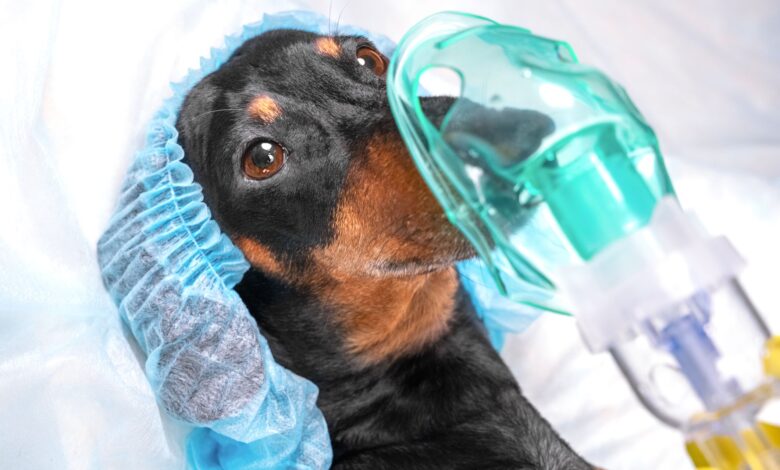
Are There Side Effects of Anesthesia in Dogs? – Dogster
[ad_1]
There are many reasons that your dog may need to undergo anesthesia in her lifetime. Anesthesia has a scary reputation among pet parents, and it only takes a few Google searches to find a scary abyss of anesthesia horror stories from fellow pet parents. Even though proper anesthesia is generally very safe, the idea of our pets “going under” is nerve-racking, and side effects of anesthesia in dogs can appear concerning. Having an informed understanding of anesthesia can help you feel more comfortable for your dog’s next anesthetic procedure.
Contents
What is anesthesia for dogs?
Anesthesia is a state of controlled unconsciousness brought upon by the administration of specific drugs. This unconscious state allows for your dog to undergo important veterinary procedures without pain or restraint. For general anesthesia in dogs, the most commonly used gasses include Isoflurane and Sevoflurane. These two options are equally safe and effective.
Anesthesia also includes local anesthesia. Examples of procedures when local anesthesia is used include punch biopsies of lumps while your dog is “awake,” a local block prior to a tooth extraction or a spinal epidural for more invasive surgeries.
Anesthesia plays a critical component to pain control before, during and after a dog’s surgical procedure. It also ensures that dogs aren’t wiggling or otherwise reacting during important diagnostics and procedures. An example includes dental radiographs. Unlike humans, dogs don’t understand the importance of remaining still during dental X-rays. Movement at this time has the potential to break important dental equipment or harm your dog. Without anesthesia, veterinarians are unable to perform dental radiographs, often resulting in undiagnosed, painful dental disease.
Most common reasons for anesthesia for dogs include:
- Dental procedures
- Mass removals
- Spay or neuter surgeries and cesarean section
- Orthopedic surgeries
- Wound repair
- Abdominal surgeries or exploratories (i.e., your dog ate a sock!)
Dog anesthesia: proper protocols
Anesthesia in dogs has changed a lot over the years in regard to both its sophistication and safety. Now, much like anesthesia for humans, anesthetic protocols take into account many aspects, including species and patient-related specifications and adjustments, as well as overall considerations for reducing anxiety and pain, and harm reduction.
Proper team roles are essential for dog anesthetic safety. A refined approach to managing a dog’s anesthesia protocol includes specific team members for:
- client counseling
- drug consideration and calculation
- administration route
- monitoring
- recovery
Team members will include the veterinarian and veterinarian nurses and or veterinarian technicians. Position titles vary from practice to practice and state to state as they have not been standardized in the United States yet, but you want vet tech/nurse team members who’ve had a science-based education and have graduated from a veterinary technician/nurse program. Vet techs and nurses always work under the supervision of a fully licensed vet.
There are ways that you, as the pet parent, can promote optimal safety, too. Your job here includes interviewing your veterinarian to better understand their anesthetic approach for your dog and whether it is considered best practice.
Some of these interview questions to ask your veterinarian before your dog undergoes anesthesia should include:
-
Will my dog have an IV catheter placed?
The answer should always be yes!
-
Will my dog receive IV fluids during their procedure?
The answer should be yes!
-
Will my dog have a dedicated veterinary nurse or veterinarian technician?
In a perfect world, your dog should actually have two nurses (or veterinarian technicians) dedicated to her surgery. For example, if one nurse is preparing your dog for surgery or cleaning her teeth, a second nurse should be assessing your dog’s vitals, such as heart rate, blood pressure and body temperature, throughout the procedure.
-
Will a nurse or veterinarian technician be with my dog during recovery?
The answer should be a solid yes. This is considered the most crucial time during the entire anesthetic event, and your dog should never be left alone during their initial recovery and extubation period.
-
Will my dog have monitoring equipment?
Monitoring equipment such as EKGs, dopplers and pulse oximeters are all very helpful in ensuring your dog’s safety and are vital for early emergency intervention during an anesthetic crisis. Monitoring equipment should never be a replacement for a dedicated surgical nurse or veterinarian technician but rather tools to support the surgical team.
-
Will my dog have pain control?
Proper pain control will reduce the amount of anesthesia needed for your dog and should begin before they are officially under anesthesia. Their pain threshold should be carefully monitored post-procedure as well and, depending on the surgery, your dog should be discharged with proper pain medications for at-home pain management.
What are the side effects of anesthesia in dogs?
For most standard procedures, dogs are discharged the same day that they have been put under anesthesia. They will spend their initial recovery time in-hospital with staff monitoring their recovery process and vitals. However, it’s not uncommon for pet parents to notice that their dog is “acting weird” that evening or even the following day.
The most common post-anesthesia side effects in dogs include dysphoria, nausea and bowel changes. Let’s break these down:
- One of the most common side effects to anesthesia for your dog will be dysphoria. By dictionary definition, dysphoria is “a state of unhappy, uneasy or dissatisfied.” If your dog seems to be acting weird after anesthsia, there is a good chance that she is dysphoric.
Examples of ways dysphoria shows up in dogs include:
- Whining and crying
- Pacing or discoordination
- Grogginess and feeling unsettled
- Uninterested in food or water
- Third eyelids are visible
Your dog’s veterinary team will assess your dog’s level of dysphoria. In cases of severe dysphoria, your veterinarian may administer additional drugs post-procedure to counteract post-anesthesia dysphoria. It’s important to understand that while dysphoria can be extremely uncomfortable to witness, dysphoria and pain are different. Your veterinarian will be able to determine the difference, and if you’re ever worried that your dog is in pain, never hesitate to contact your veterinary team. That is what they are there for and it is always better to ask and receive an answer than not ask and anxiously worry or wonder.
The good news is post-anesthesia dysphoria is usually most common the day of and day after anesthesia, and generally resolves within 1 to 2 days.
- Anesthesia may cause your dog to feel some level of nausea and therefore she may vomit and/or experience a lack of appetite. Many veterinarians will recommend a smaller dinner the night your dog returns home after anesthesia. Don’t be concerned if your pup doesn’t dig right in, even if she is the most food motivated dog in town!
- Bowel changes. You may notice that your dog doesn’t poop at all for a few days post-anesthesia. Alternatively, your dog may have loose stools. Either of these side effects can be normal.
Anesthetic complications in dogs
While anesthesia is generally very safe for dogs when properly executed, it is a medical procedure and with that comes inherent risk. Certain dogs are more susceptible to complications or need specific considerations for optimal safety.
Myth-buster: Your senior dog does not automatically qualify as a high-risk anesthetic candidate. In fact, most senior dogs do just fine under anesthesia. Age is not a disease!
Animals who are considered high-risk candidates for anesthesia and may require individualized care prior, during or after their anesthetic procedure include:
- Dogs with heart disease
- Brachycephalic dogs (dogs with squished faces like Pugs, Boston Terriers or English Bulldogs)
- Sighthounds like Greyhounds or Whippets (they have slow anesthetic drug breakdown and veterinarians have special anesthesia protocols for them. Discuss with your veterinarian).
- Dogs with kidney disease
Preparing your dog for anesthesia
There are really simple ways that you can prepare your dog for anesthesia that do not require much effort and go a long way in ensuring your dog is safe and comfortable.
These steps include:
- You will always fast your dog prior to anesthesia. Some anesthetic protocols induce nausea. If your dog has a full belly, they are more likely to vomit during their procedure and while intubated. Such an event could have dangerous consequences including aspiration pneumonia. Your veterinarian will provide you with the proper fasting protocol.
- Follow medication protocols. There is a possibility that your veterinarian will prescribe pre- or post-procedure medications such as antibiotics or pain medications. Be sure that you are following these protocols.
- Create a safe recovery space. Create your pup’s home recovery environment with compassion and strategy. Ensure your home is not loud and chaotic, or find a quiet room for your dog to spend the evening in. Dim the lights and provide your dog with passive touch or soothing words during this time. You are their safe space, and your presence alone will be extremely healing.
A study organized by the National Center for Biotechnology Information (NCBI) concluded that 99.8% of pets (regardless of their age) survive anesthesia.
This is a remarkably successful number, and one that I hope eases your worried pet-parent mind and provides you with confidence in allowing your dog to receive optimal medical care even when anesthesia is involved. With the right safety precautions and considerations, as well as your compassion and advocacy, your dog will be a healthier version of themselves because of it!
Looking for a specialist?
Most routine dog medical procedures are performed by primary care veterinarians rather than veterinary anesthesiologists due to the extra cost and lack of available veterinary anesthesiologists. However, high risk cases should be referred to a veterinary hospital with a veterinary anesthesiologist, who has completed several years of additional anesthesia specialty training and has passed the anesthesiology board certification examination.
[ad_2]





